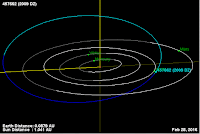Asteroid
2016 FC1 passed by the Earth at a distance of 167 800 km (0.44 times
the average distance between the Earth and the Moon, or 0.11% of
the average distance between the Earth and the Sun; 147 800 km above the
orbit at which the satellites supporting GPS systems operate), slightly before 2.30 pm GMT on Monday 14 March 2016. There was no
danger
of the asteroid
hitting us, though had it done so it would have presented only a minor
threat. 2016 FC1 has an estimated equivalent diameter of 2-9 m (i.e.
it is estimated that a spherical object with the same volume would be 2-9 m in diameter), and an object of this size would be expected to
explode in an airburst (an explosion caused by superheating from
friction with the Earth's atmosphere, which is greater than that caused
by simply falling, due to the orbital momentum of the asteroid) in the
atmosphere more than 32 km above the ground, with only fragmentary
material reaching the Earth's surface.
2016 FC1 was discovered on 16 March 2016 (two days after its closest approach to the Earth) by the University of Arizona's Mt. Lemmon Survey at the Steward Observatory on
Mount Lemmon in the Catalina Mountains north of Tucson. The designation
2016 FC1 implies that the asteroid was the 28th object (object C1)
discovered in the second half of March 2016 (period 2016 F).
2016 FC1 has a 1080 day orbital period and an eccentric orbit tilted at an
angle of 1.24° to the plane of the Solar System that takes it from 0.74
AU from the Sun (i.e. 74% of the average distance at which the Earth
orbits the Sun, slightly outside the orbit of Venus) to 3.38 AU from the Sun (i.e. 338% of the average
distance at which the Earth orbits the Sun, considerably more than twice the
distance at which Mars orbits the Sun). It is therefore classed as an
Apollo Group Asteroid (an asteroid that is on average further from the
Sun than the Earth, but which does get closer). 2015 XE also has occasional
close encounters with the planet Mars, with the next predicted in July 2039.
See also...
 Bright 'fireball' meteor seen over much of England. The UK Meteor Observation Network
has recieved roports of a bright fireball meteor being seen over much
of southern England...
Bright 'fireball' meteor seen over much of England. The UK Meteor Observation Network
has recieved roports of a bright fireball meteor being seen over much
of southern England... Asteroid 2007 DM41 passes the Earth. Asteroid 2007 DM41 passed by the Earth at a distance of 12 400 000 km
(32.3 times the average distance between the Earth and the Moon, or
8.29% of the average distance between the Earth and the Sun), slightly
before 12.10 pm GMT on Tuesday 23...
Asteroid 2007 DM41 passes the Earth. Asteroid 2007 DM41 passed by the Earth at a distance of 12 400 000 km
(32.3 times the average distance between the Earth and the Moon, or
8.29% of the average distance between the Earth and the Sun), slightly
before 12.10 pm GMT on Tuesday 23... Asteroid (457662) 2009 DZ passes the Earth. Asteroid
(457662) 2009 DZ passed by the Earth at a distance of 12 510 000 km
(32.5 times the average distance between the Earth and the Moon, or
8.36% of the average distance between the Earth and the Sun), slightly
before 2.35 am GMT on Tuesday 23...
Asteroid (457662) 2009 DZ passes the Earth. Asteroid
(457662) 2009 DZ passed by the Earth at a distance of 12 510 000 km
(32.5 times the average distance between the Earth and the Moon, or
8.36% of the average distance between the Earth and the Sun), slightly
before 2.35 am GMT on Tuesday 23...
Follow Sciency Thoughts on Facebook.

